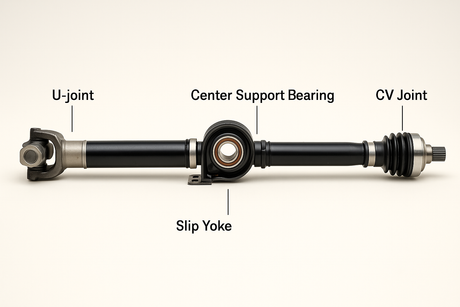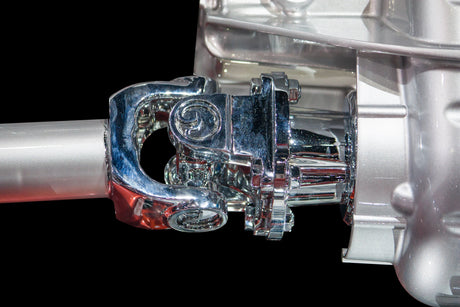When it comes to drivetrain performance, the driveshaft is an integral component that doesn’t always get the spotlight it deserves. Yet, without it, your vehicle simply wouldn’t go. If you're a mechanic or automotive enthusiast, understanding the essential parts of a driveshaft and knowing how to identify issues with them is crucial to keeping your ride in top shape. In this post, we’ll break down the core components of the driveshaft system and explain how each part contributes to performance, so you can keep your vehicle in prime condition.
1. Driveshaft Tube: The Backbone of Your Driveline
The driveshaft tube, often made of steel or aluminum, is the central component of the entire system. Its job is to transmit torque from the engine to the wheels, and it needs to be strong and durable to handle the immense stress it faces. If your vehicle experiences vibrations or if you hear a grinding noise, it could be due to a bent or damaged driveshaft tube. In high-performance or off-road vehicles, this part is particularly susceptible to wear due to harsh conditions.
Key Highlight: The driveshaft tube ensures that torque is transferred smoothly and efficiently from the engine to the wheels, crucial for overall vehicle performance.
2. U-Joint: The Flexible Link
U-joints, or universal joints, are the flexible connectors that link the driveshaft to the vehicle’s differential or transmission. These small but powerful components allow the driveshaft to flex and move with the vehicle’s suspension without losing torque. If the U-joint becomes worn, you’ll likely hear a clunking or squeaking noise, especially when turning or accelerating. Regular lubrication is key to preventing premature wear.
Key Highlight: U-joints provide the essential flexibility needed for power delivery, allowing for smooth motion even as the suspension moves.
3. Slip Yoke: The Extension That Adapts
The slip yoke is the part that allows the driveshaft to adjust its length as the suspension moves. This flexibility ensures that the driveshaft doesn’t become too rigid, which would cause the drivetrain to bind and cause significant damage. If the slip yoke is worn, you may notice a shudder or a noticeable thump when accelerating or decelerating. Grease it regularly to keep it functioning smoothly.
Key Highlight: The slip yoke adjusts to the suspension's movement, preventing damage and ensuring the driveshaft remains flexible.
4. Yoke: The Connection Point
The yoke is the component that connects the driveshaft to the vehicle’s differential or transmission. There are slip yokes, which allow for movement, and fixed yokes, which don’t slide. A damaged yoke can lead to alignment issues, excessive wear, and even failure of the driveshaft. Inspecting and maintaining the yoke is crucial for a seamless drivetrain operation.
Key Highlight: The yoke is the critical connection that transfers power from the driveshaft to the differential or transmission, ensuring seamless performance.
5. CV Joints: Constant Velocity, Constant Power
For front-wheel-drive and all-wheel-drive vehicles, CV (Constant Velocity) joints are essential for maintaining torque while accommodating the vehicle’s steering and suspension movements. Unlike U-joints, CV joints can handle sharper angles without sacrificing power transfer. Over time, CV joints can develop cracks in the boot or become contaminated with dirt, leading to clicking sounds when turning. Replacing worn-out CV joints is crucial to preventing drivetrain failure.
Key Highlight: CV joints are essential for smooth power transfer at sharp angles, especially for front-wheel and all-wheel-drive vehicles.
6. Center Support Bearing: The Stabilizer
The center support bearing supports the midsection of the driveshaft, particularly in longer driveshafts or those with two-piece designs. Its job is to keep the driveshaft properly aligned and reduce vibrations. If this bearing fails, you’ll likely notice increased vibrations, especially at higher speeds. Regular inspection of the center support bearing is vital for ensuring smooth drivetrain operation.
Key Highlight: The center support bearing stabilizes the driveshaft’s midsection, reducing vibrations and maintaining balance for smooth driving.
7. Differential: The Power Splitter
Although not technically part of the driveshaft itself, the differential plays an essential role in distributing the engine’s power to the wheels. It ensures that the wheels rotate at different speeds, which is especially important when turning. Without a properly functioning differential, your driveshaft will struggle to transfer power, leading to handling issues and drivetrain strain. Keeping your differential fluid fresh and free of contaminants is key.
Key Highlight: The differential ensures smooth turns by allowing the left and right wheels to rotate at different speeds, making power distribution efficient.
8. Pinion Gear: The Power Converter
The pinion gear is a critical part of the differential, converting rotational power from the driveshaft into the rotational force needed to turn the wheels. This small but powerful gear interacts with the ring gear to enable the differential’s operation. Worn pinion gears can lead to a whiny noise or poor power transfer, requiring immediate replacement.
Key Highlight: The pinion gear is the intermediary between the driveshaft and differential, converting rotational energy to move the vehicle.
9. Flange: The Joint Connector
The flange is another essential part that connects the driveshaft to the differential or transmission. It's often found on high-performance or heavy-duty vehicles and is more durable than yokes, offering a more secure connection. If you notice vibrations or hear a grinding sound, check the flange for signs of wear or misalignment.
Key Highlight: The flange provides a more secure, rigid connection for high-torque applications, ensuring a strong link between the driveshaft and differential.
10. Carrier Bearing: The Backbone for Two-Piece Driveshafts
A carrier bearing supports the middle section of a two-piece driveshaft, preventing it from wobbling or bending. Carrier bearings are often used in vehicles with longer driveshafts to maintain balance and prevent vibration. If a carrier bearing fails, you’ll notice excessive vibration, particularly under acceleration.
Key Highlight: The carrier bearing stabilizes the driveshaft, providing crucial support for vehicles with longer or two-piece driveshaft systems.
Why Regular Inspection of Driveshaft Parts Is Crucial for Vehicle Performance
Proper maintenance and timely replacement of these essential driveshaft components can prevent costly repairs and improve the overall performance of your vehicle. If you start noticing vibrations, unusual noises, or power delivery issues, it’s time to inspect your driveshaft parts for wear or damage.
Regular maintenance, including lubrication, inspection for signs of wear, and immediate replacement of any damaged parts, can extend the lifespan of your vehicle’s drivetrain and ensure your rides stay smooth and reliable.
Stay Ahead with Driveshaft Part Care
As an automotive professional or enthusiast, understanding the roles of each driveshaft component is key to diagnosing issues and keeping your vehicle running like new. By maintaining the health of your driveshaft parts—like U-joints, slip yokes, CV joints, and more—you’ll maximize performance, prevent breakdowns, and keep your vehicle in top condition for years to come.
Remember, early detection of problems can save you from more extensive (and expensive) repairs down the line. Keep your driveshaft system well-maintained, and you’ll be on the road for many more miles of smooth driving.






